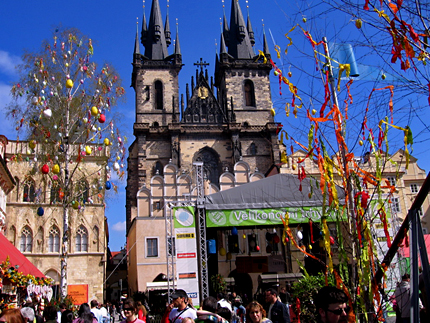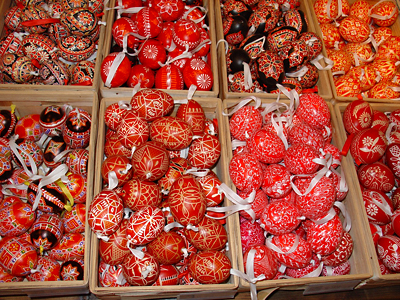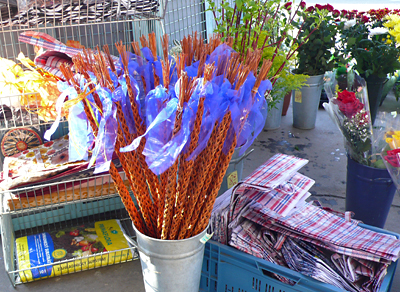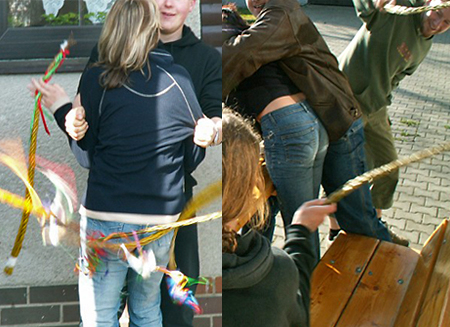Easter is a very important celebration both in the Czech Republic and Slovakia, called Velikonoce – from Veliké noci or Great Nights. Although the religious connotations of Easter were suppressed under the communist regime, nowadays Czechs and Slovaks are again aware of the strong Christian background of Easter, although they regard it as mostly fun times. Many traditions are still observed, especially in villages. Several bloggers have been describing some of them.
 [1]
[1]
Easter [2] by Nic Hyland [3], used under a Creative Commons Lincense.
Green Thursday
The Thursday before Easter is the day of the last supper, when Jesus Christ feasted with the apostles on lamb with bread and wine. Because of that, it is usual to bake lamb for Easter, but now real lamb often gets replaced with gingerbread lamb replica. The Journeys of Captain Oddsocks explains that Green Thursday is so called “because of the long green robes worn in church and the spinach and cabbage traditionally eaten on the day.” He also describes the customs of the day [4]:
… customs include the boys’ game Chasing Judas, and the baking of twisted spiral buns representing serpents, the symbols of betrayal. In some villages there are processions led by a captive Judas in a straw suit which is ceremonially burnt at the end of the day. When sprinkled into a clean jug of water, the ashes of Judas were believed to have special powers including the abilities to guard against fire and protect the health of livestock for the coming year.
Easter Sunday
The Journeys of Captain Oddsocks describes Easter Sunday [4] as “the big day”:
The day that Christ rose from the grave, the day of new life cleansed of suffering and victorious over death. The morning is for attending church services, (the bells having returned from Rome) and the early afternoon is set aside for a great feast. After the meal it’s time to visit relatives, and in some places to ride in a horseback procession through the countryside with blessed twigs to ensure fertile fields for the year ahead. While the men and boys are out gallivanting around on horses, girls are at home decorating eggs in preparation for the following day.
 [5]
[5]
Egg Time [6] by Semmi [7], used with permission.
Easter eggs are called kraslice, from the old Czech word krásný, meaning red, which was the most common colour used for dying. The designs are usually very intricate and, as The Foreigner's Guide to Living in Slovakia points out [8], “some eggs are even decorated by using a drill and hollowing out portions of the shell”. In fact, the techniques used to hand-paint and decorate them are truly an art form, and there are even competitions for the best kraslice and a museum dedicated to the craft.
During the weeks preceding Easter, Czech and Slovak cities have street markets selling kraslice, gingerbread lambs and other Easter items, such as the one in Prague's Old Town Square, photographed [9] by My Czech Republic Blog.
Red Monday
Easter Monday practices, involving boys pouring water over girls and lightly whipping them with braided branches, are the most controversial of Easter traditions. As The Foreigner's Guide to Living in Slovakia explains, “if you are not Slovak and didn’t grow up around these traditions, you might find them at best—odd, at worst—barbaric.”
 [10]
[10]
What? [11] by Laura Appleyard [12], used under a Creative Commons license.
So what happens exactly on Easter Monday? The Czech Daily World explains the pomlázka whipping tradition [13]:
Throughout the day men (usually in groups) visit their female relatives and friends and spank them with special whips. […] These whips are hand-made from willow rods, the length ranges from 50 centimeters to two meters. There are ribbons at the end. There used to be a tradition that women would add their own ribbons so the whip would say how many women the particular man has already visited but this seems to fizzle out. And women are chased around (if they decide to make it interesting or to play along), or they just stand motionless and the male visitors would spank her butt. However, it should not hurt. Or at least not throughout the whole procedure.
The Foreigner's Guide to Living in Slovakia explains [14] why willow branches are used to make the pomlázka (which is called korbáč in Slovak): “It is the first tree that ‘wakes’ in spring and, according to folk tradition, the fertility and vitality from the branches were thought to flow into the woman during this act.”
Czech Mate Diary explains [15] the exchange taking place during the whipping:
If you were one of the first houses the mob visited, you were lucky: the guys are still kind of sober, kind of polite and kind of mellow. You let them into the living room – or better – just a hallway, give them some refreshments, offer them more vodka and let them “spank” you. If they still have their egg baskets, you would also stuff couple of eggs in them and if you are lucky they leave afterwards.
 [16]
[16]
Pomlázka whipping in the village of Hříchovice [17], near Pilsen.
Tischler's in Prague posted an article [18] from the Prague Daily Monitor on an American woman's reaction to the tradition:
…men and boys […] go door to door singing Easter carols, demanding “treats” (eggs, chocolate, liquor, or a peck on the cheek) and the right to beat the women with their pomlázka whips for good luck. While my female students said they generally enjoyed decorating Easter eggs and preparing Easter sweets, none seemed too fond of the pomlazka or gendered traditions.
[…] Being both female and a foreigner, I presented a problematic situation. Should our hostess offer me chocolate eggs and liquor as she did her male friends? Should she offer me nothing? In the end, I was given a warm welcome and a glass of red wine.
In addition to whipping, Easter Monday also involves dousing. According to The Journeys of Captain Oddsocks [4], in some regions the girls get their revenge on Tuesday when it’s their turn with the whips, while in other regions they return the rejuvenation with a bucket of ice-cold water. In Slovakia, however, it seems that it's the girls who get watered on Easter Monday. The Foreigner's Guide to Living in Slovakia explains the ritual [14]:
…it’s customary for the girls and women to stay at home while the boys and men, usually dressed in nicer clothing and sometimes even in kroj – traditional costume, go from the residence of one relative to another, bringing greetings and intending to oblievat’ – to “water” the female relatives present. Water is the symbol of life and the pouring of water is a gesture meant to bestow year long health and beauty. Some use a spray of perfume instead of water, or both.
Isn’t that nice? The women folk get watered and whipped while the men get fed and given drinks, and the little boys are given money or chocolate in exchange for their work of the day. Just so you know, being watered can range from having a teaspoon of warm tap water dribbled over you (my personal experience), to a bucket of frigid well water thrown at you.